 John Mata Jr.
.
February 11, 2021
.
America
John Mata Jr.
.
February 11, 2021
.
America
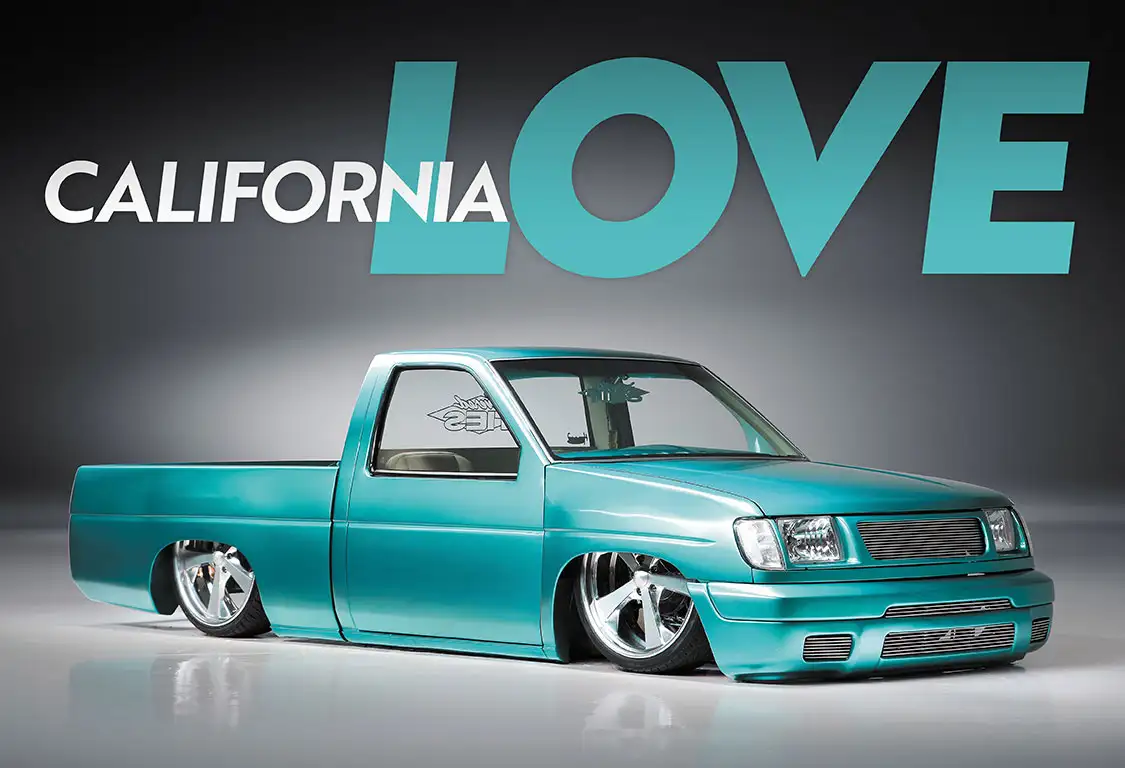
Ever since he can remember, Jeff Popiolek has been California dreaming. Born and raised in Chicago, he grew up fantasizing about the West Coast lifestyle. Little did he know purchasing a 1990 Nissan Hardbody would complete his dream.
“I really don’t know what it was exactly that I was so attracted to about life in SoCal,” Jeff admits. “It really wasn’t one particular thing that drew me in, but a fascination with the surf and skateboarding cultures, along with the year-round sunshine, palm trees and cool cars everywhere.”
A first Jeff’s parents figured his dreams of someday escaping the Midwest would fizzle out, but as soon as he was old enough and able to go, Jeff packed up and hit the road.
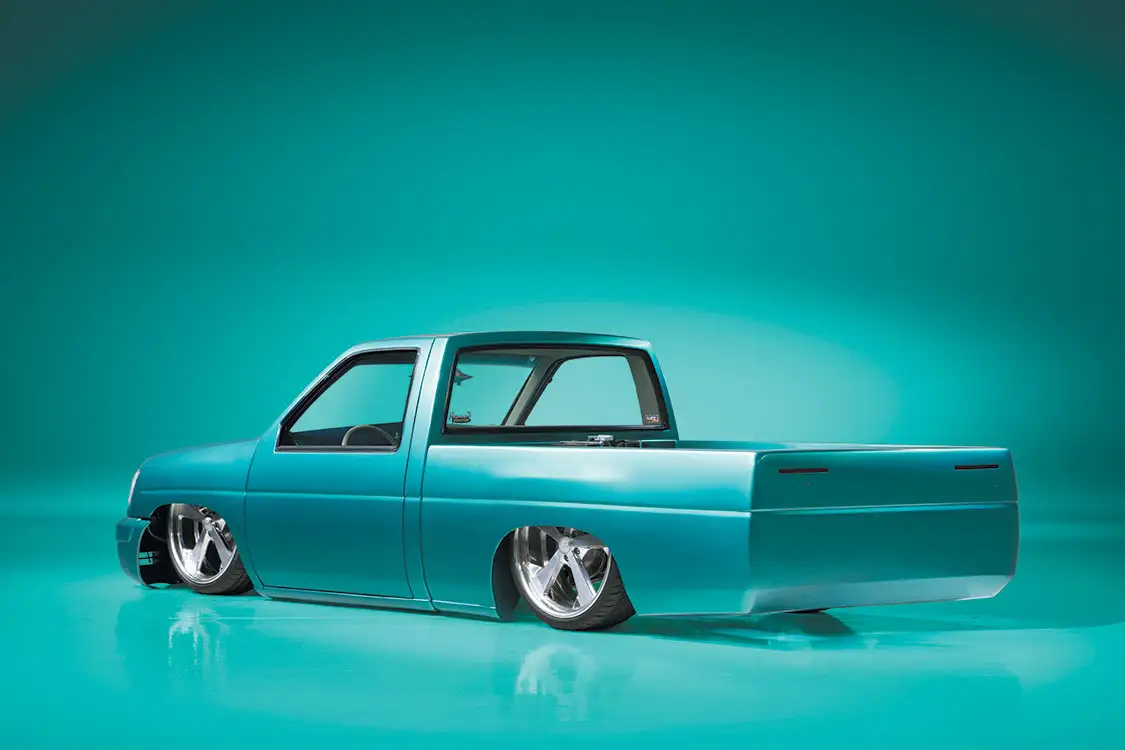
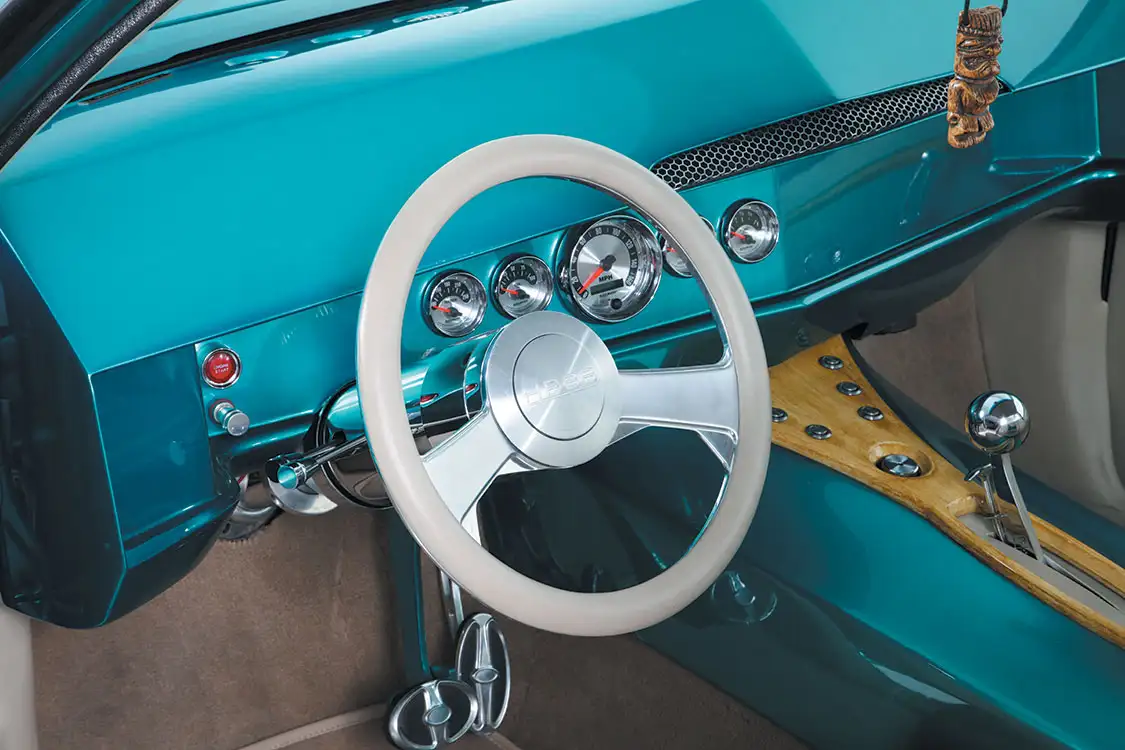
In 2013 Jeff left the freezing winters behind but brought his love of custom vehicles along with him. Customized import tuners used to be his thing. After arriving in California, he took an instant liking to the sport truck scene. Jeff is an avid car show attendee and photographer, so he makes his rounds when he’s out and about. Before he knew it, Jeff was a Severed Ties petitioner and was presented with an opportunity to purchase a 1990 Nissan hardbody a previous Mini Truckin’ cover truck (Aug. 2013) from a fellow member.
“I was hearing that I should do something to change up the truck before showing it on a regular basis, while at the same time I had folks comment that it would be sacrilege to make major alterations to a cover truck.”
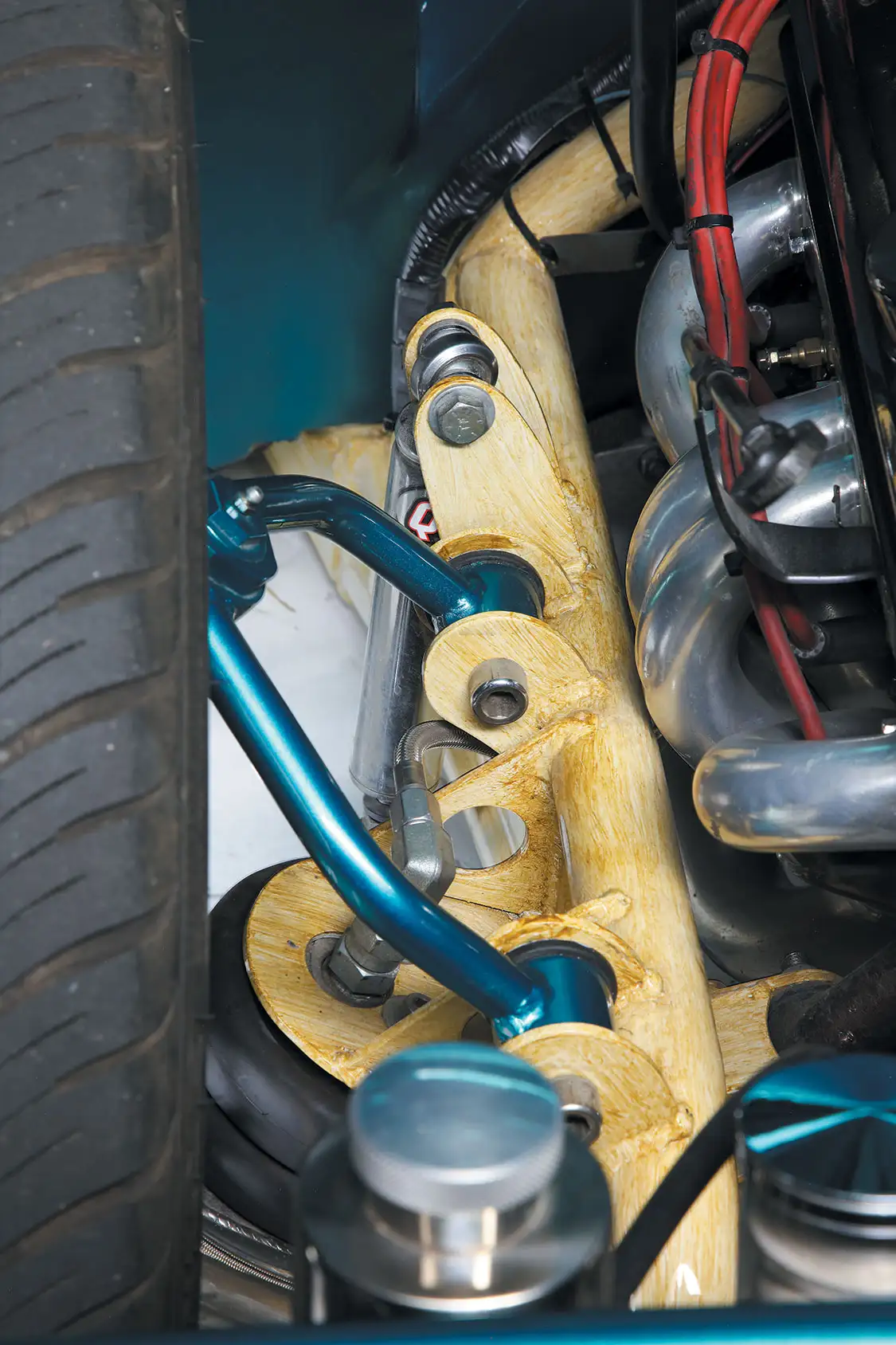
In the end, Jeff acted on the initial instinct he felt before he even officially took ownership on this 1990 Nissan Hardbody. Ultimately, he planned to make the truck his own by seeing through with his own changes that better represented his personal vision while still respecting the level of craftsmanship its previous owner invested in it.
Being a seasoned painter, Jeff first considered all the color scheme options that could freshen up his Nissan. He even had a manageable deadline (2019 Forbidden Fantasy show) to make all the changes necessary to call this truck his own.
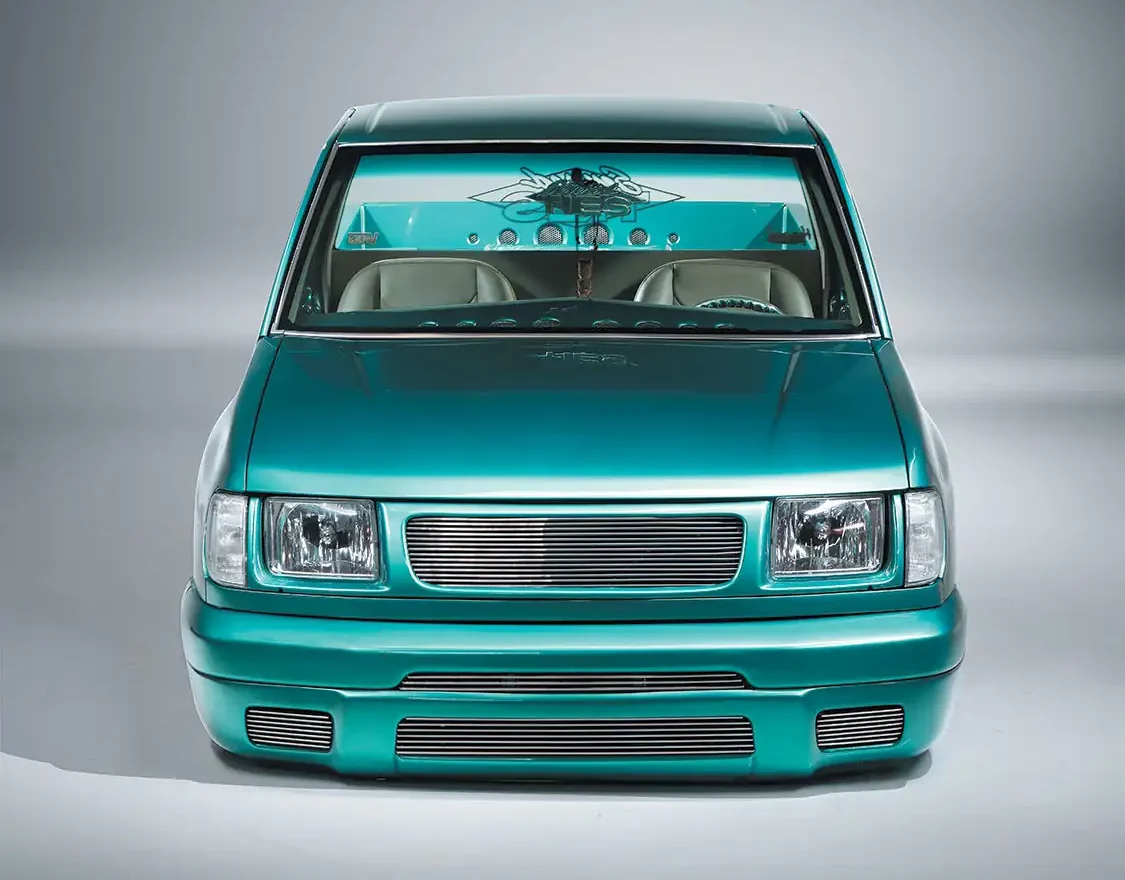
The color palette Jeff seemed to be coming back to was the perfect shade of blue to represent water, tan for sand, and a bronze to make up the look of other seaweed and rocks that are also found along the coast. Many colors were sampled and tested before finally landing on the perfect combination.
With a loose theme going, Jeff wanted to push the paintwork further by reaching out to an established SoCal airbrush artist to take the Nissan to the next level. Alan Farias of AK Airbrushing and Auto Body worked overtime to give the entire chassis the look of weathered driftwood to add more texture to the truck’s new beachy vibe. The well-executed airbrush work also gave the truck some very realistic water graphics as well to solidify the cohesiveness of the truck’s creative overhaul.
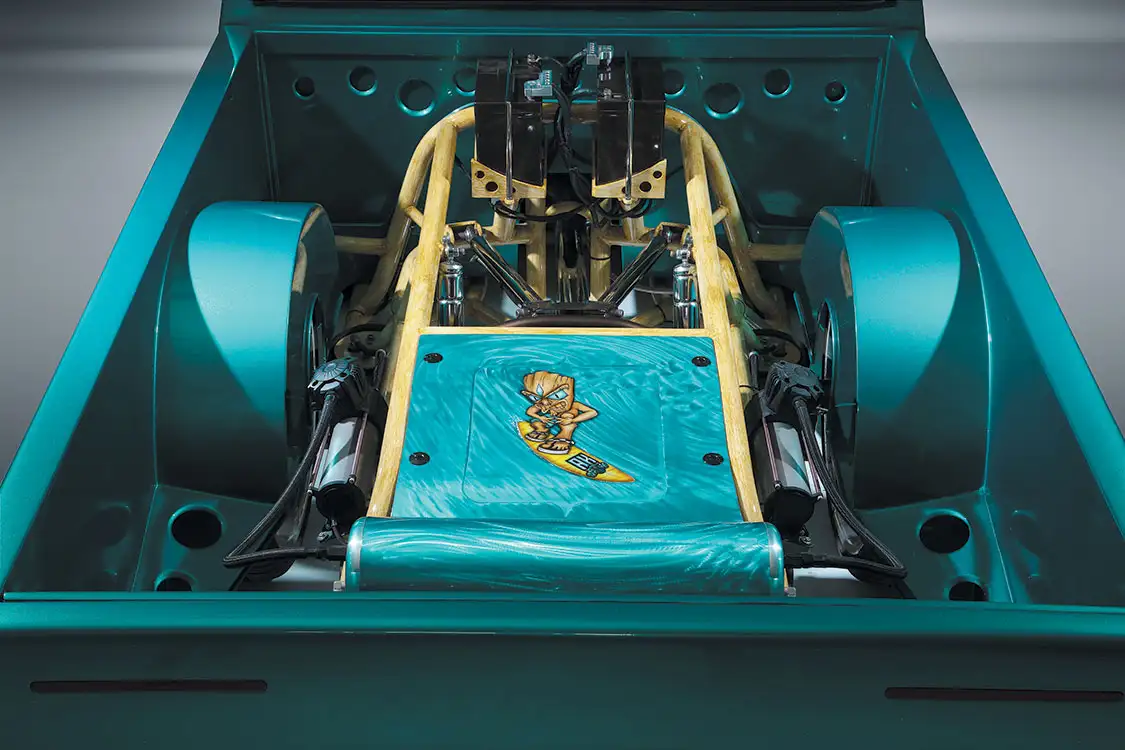
With much more work to do, Jeff pressed on and moved inside the cab. Where more subtle touches were added to tie in with the Hardbody’s exterior look. Since the truck was scheduled to sit while the interior was being redone. Jeff figured it would be a great time to have the existing 327ci engine yanked out of the 1990 Nissan Hardbody and rebuilt. Even though he was doing his best to be thorough and proactive, this is the point when the entire renovation fell off the tracks.
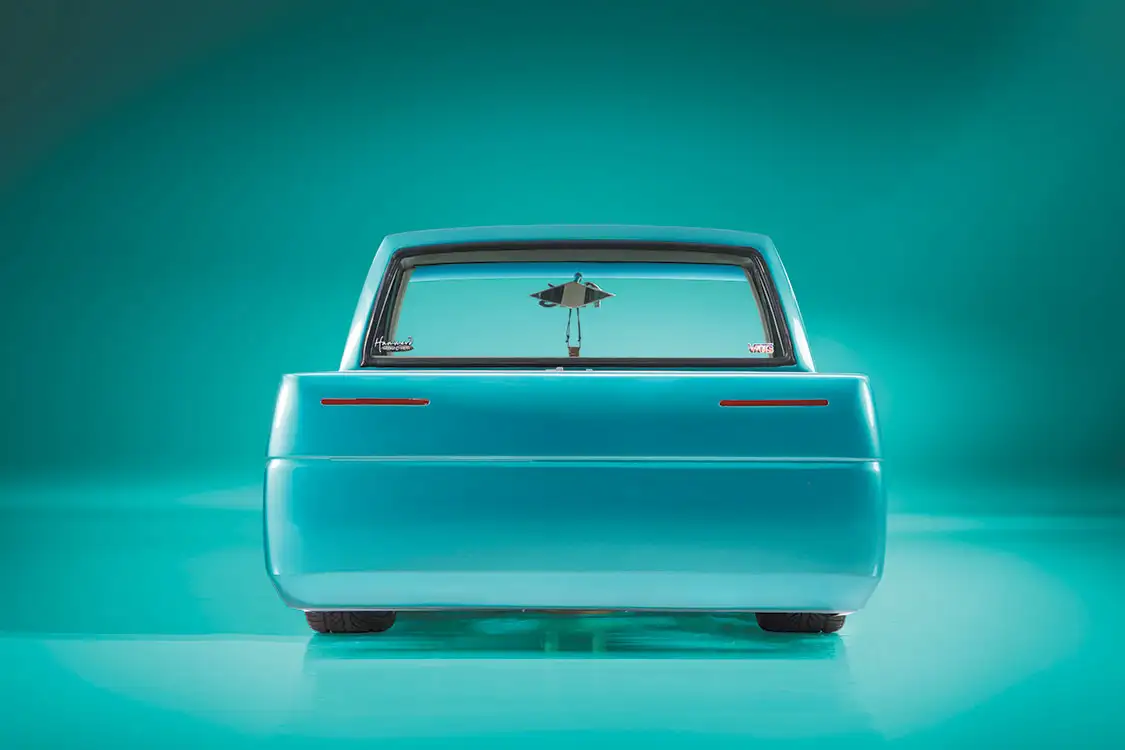
Bummed due to untimely expense and extra work involved, Jeff was still fortunate enough to be able to locate a 350ci Chevy small-block at a friend’s place that came through big time in the eleventh hour. While all this was happening, not much was going on in the interior while the truck was at the upholstery shop.
With an entire whirlwind of parts and pieces being torn off the truck. The that last week leading into what would be the truck’s big debut event, Jeff was coming to the realization that it wouldn’t happen. The feeling of disappointment was all too real, but luckily, he underestimated the crew. As a result pulling all-nighters in a last-ditch effort to get the 1990 Nissan hardbody ready for the spotlight.
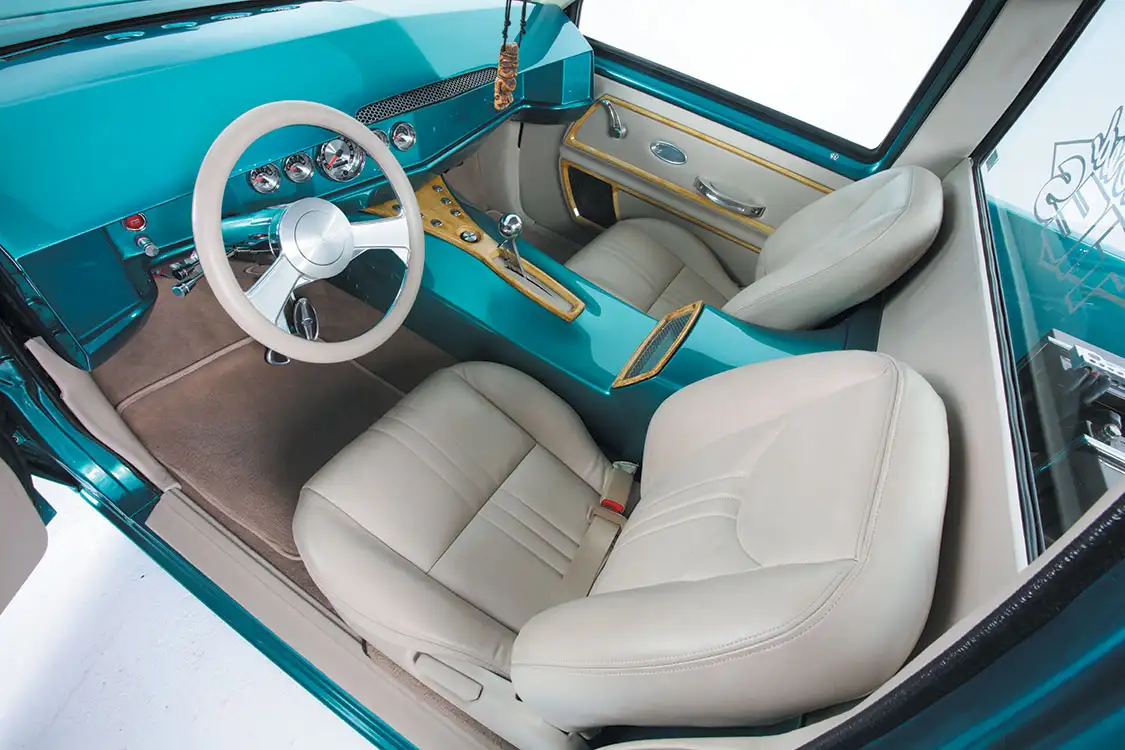
There are somethings that have a weird way of working out if they’re meant to be. The response to Jeff’s restyled ride has been mostly amazing except for the comments about “ruining” a past cover truck, but he isn’t at all bothered by them. The way he sees it, while the truck was already in perfect condition when he started with it the decision to put his own spin on. He kept the chassis and suspension work in place. While drastically altering everything around it, while still finding a way to incorporate the actual tube frame and components into a very vital portion of the truck’s reimagining.
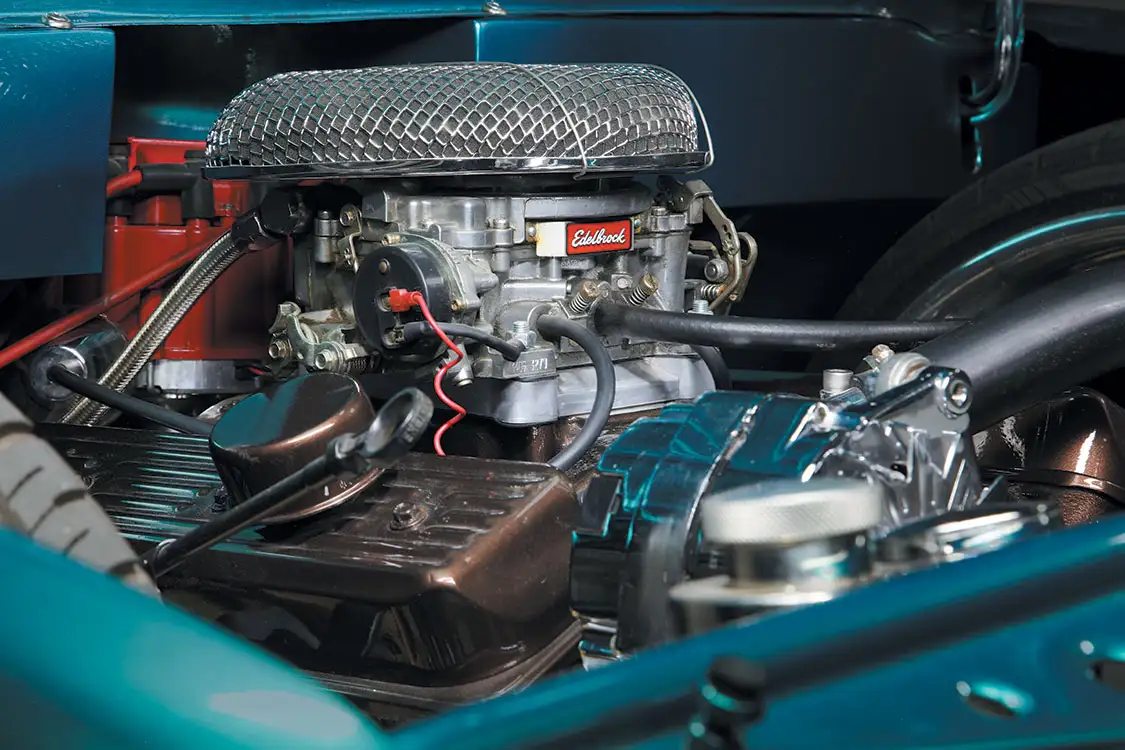
With a fresh perspective on the California lifestyle, Jeff can kick back and drive his beach-themed to the actual beach. The place that inspired not only the type of custom he recreated for himself. Although more importantly, a new way of life he has adopted and thrived in.
“Everything has been amazing since I’ve moved to the West, and I’d like to thank everybody who has played such an important role in building a truck that has become extremely meaningful to me.”
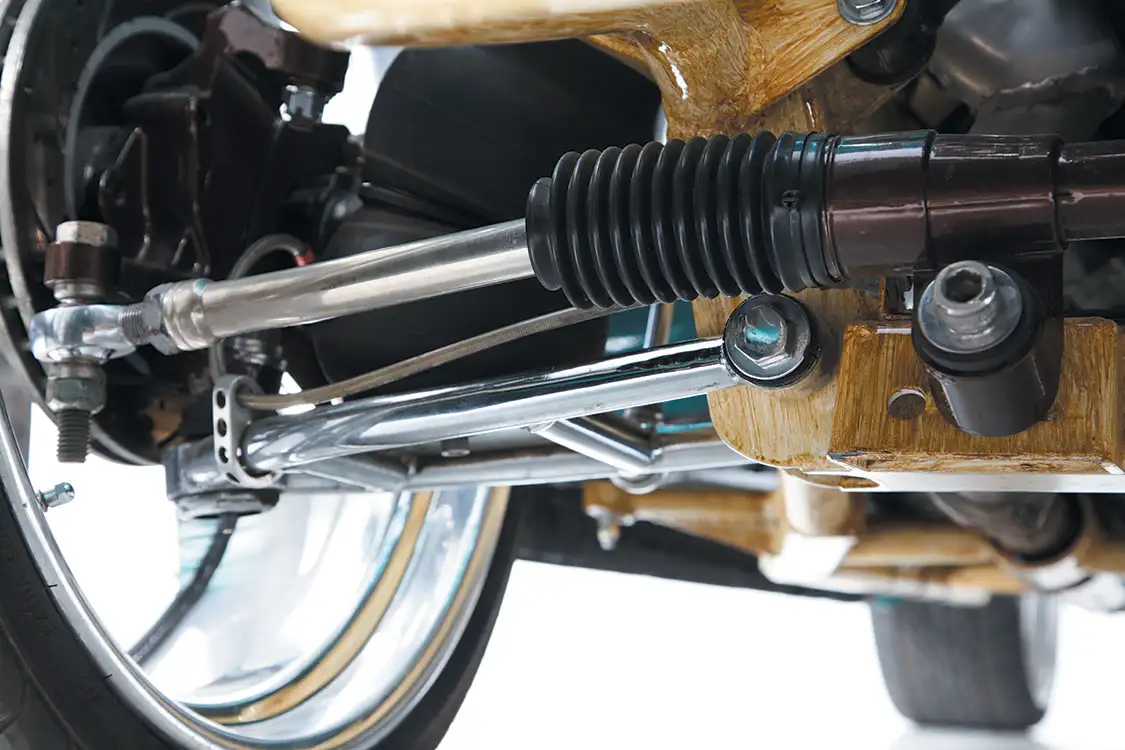
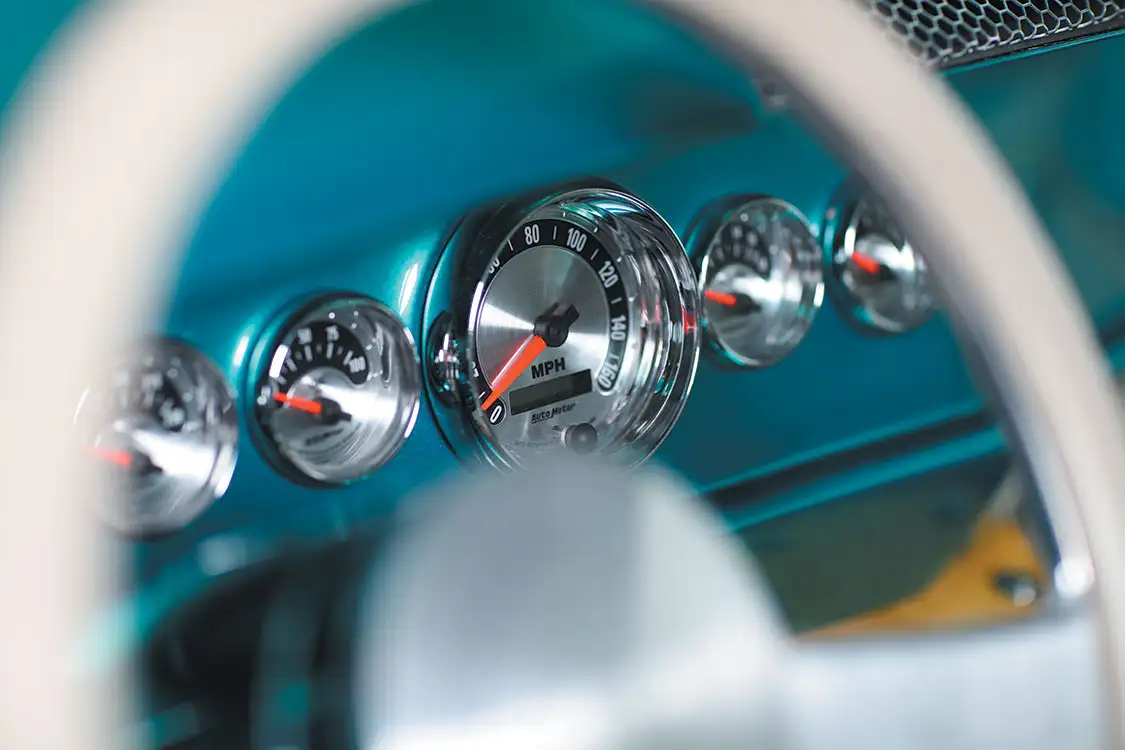
Owner
Jeff Popiolek
1990 Nissan Hardbody
Orange, California
Club: Severed Ties
Engine
Shop: Robbie Robbins
Chevy small-block 350ci
Edelbrock 1406 carb
Ceramic-coated headers
Straight pipe exhaust
MSD ignition
Painted engine block
Apex 240-amp alt
Billet pulleys
Aluminum Mishimoto radiator
Braided fuel lines
Chrome driveline and coolant reservoir
700R4 transmission mounted to tube chassis
B&M shifter
Suspension
Chapy Andrews at Sinister FAB Werks, SLC, Utah
1 ¾-inch tube chassis
Mustang II IFS
Slam Specialties RE-6 (front)/RE-7 (rear) ‘bags
Painted upper and lower arms
QA1 chrome shocks
Custom rear four-link
Custom fuel cell
Painted suspension components
Wheels & Tires
22×9 Hot Rods By Boyd H.O.F wheels polished w/ brushed faces
245/30/22 Lexani tires
Brakes
Little Shop S-10 disc brake conversion w/ drilled and slotted rotors
Painted calipers
Wilwood master cylinder
Body/Paint
Shop: Alan Farias AK Airbrushing & Auto Body, Riverside, CA
Teal Pearl paint with pulverized diamonds
Shaved firewall, handles, gas door, side mirrors, tailgate, taillights
Custom fuel cell cover
Custom cut billet grille
Interior
Honda Civic seats cut and reshaped
Parchment colored leather and vinyl upholstery
Auto Meter gauges
Hot Rods By Boyd H.O.F. steering wheel
Custom door panels, console, speaker box, headliner, panels
Billet Specialties pedals, door pulls, window cranks
Ididit steering column
Lokar handles
Painted dash from a ’64 Cadillac trunk lid
Powerbass head unit
JL Audio signal processor
What made the Toyota minitrucks of the ’80s and ’90s so beloved?
During the ’80s and ’90s, Toyota’s minitrucks captured the hearts of many enthusiasts. So, what exactly made these compact workhorses so adored? Let’s delve into the key reasons:
First and foremost, their reputation for reliability was nearly unmatched. These trucks could endure tough conditions, clocking high mileage with minimal issues. Owners found them dependable for both daily commutes and rugged adventures.
Cultural influence played a crucial role. Pop culture, including iconic movies like Back to the Future, showcased these vehicles as symbols of coolness and adventure. This media exposure cemented their status in the public eye.
‘s minitrucks weren’t just about image; they were incredibly practical. Their compact size made them perfect for city driving, while their durable build handled off-road conditions effortlessly. They offered a versatile solution for diverse needs, from light hauling jobs to weekend escapades.
Lastly, the ease of maintenance and widespread availability of parts made these trucks cost-effective to own. An abundance of aftermarket support allowed owners to personalize and enhance their vehicles to suit individual tastes and needs.
In summary, Toyota’s minitrucks of the ’80s and ’90s gained their beloved status through a combination of unmatched reliability, cultural significance, practicality, and ease of maintenance. These attributes created a lasting legacy admired by many to this day.
Why are ’80s and ’90s Nissan pickups considered classics?
The ’80s and ’90s Nissan pickups deserve recognition as classics for several compelling reasons:
In conclusion, the distinctive styling, robust performance, significant cultural impact, and impressive capabilities all contribute to why ’80s and ’90s Nissan pickups are rightfully considered classics today. Whether for their nostalgic appeal or their enduring functionality, these trucks continue to captivate enthusiasts and collectors alike.
How successful was the Nissan Hardbody in terms of sales and popularity?
The Nissan Hardbody achieved impressive sales figures and gained substantial popularity during its production years. While it may not have reached the lofty heights of its competitor Toyota in terms of legendary quality, it carved out its own niche in the truck market.
In summary, the Nissan Hardbody’s success is evident through its robust sales performance and the substantial customer base it built, making it a notable player in the truck segment.
What engine options were available for the Nissan Hardbody in the US?
The Nissan Hardbody available in the US offered two main engine options. Initially, it came with a 2.4L four-cylinder engine. This engine began as a Z-series and was later replaced in 1990 by the KA24E SOHC motor, the same engine found in the 1989-1990 240SX.
For those seeking more power, a 3.0L V6 engine was also available, derived from Nissan’s VG family of engines. While US models featured these specific powertrains, it’s notable that smaller four-cylinder engines and turbodiesel options were available in international markets.
What configurations and options were available for the Nissan Hardbody in the US market?
The Nissan Hardbody offered various configurations and options tailored to meet diverse needs in the US market:
While the US market enjoyed these specific configurations, smaller displacement four-cylinder engines and turbodiesel variants were available in international markets, showcasing the versatility and broad appeal of the Nissan Hardbody.
What were the design features of the Nissan Hardbody?
The Nissan Hardbody, a staple of 1980s and 1990s truck design, introduced a new level of style and functionality to the pickup market when it debuted in 1986. Its bold and modern aesthetics set it apart from its predecessor, the 720 pickup.
The Nissan Hardbody successfully combined functional design, robust performance options, and a versatile configuration setup, making it a favorite among truck enthusiasts globally.
What was the ‘Desert Runner’ version of the Nissan Hardbody?
The “Desert Runner” was a specialized off-road version of the Nissan Hardbody released in 1988. This model stood out due to its factory-installed off-road enhancements, making it ideal for rugged terrain. With its unique ’80s design, it embodied the era’s adventurous spirit and offered enthusiasts a vehicle that was both stylish and capable in challenging conditions.
In summary, the Desert Runner merged robust performance with an iconic ’80s look, making it a favorite among off-road enthusiasts.
In what other types of racing did the Nissan Hardbody participate?
The Nissan Hardbody didn’t stop at off-roading; its versatility extended into various racing arenas. Beyond conquering the Mint 400 and Baja 500, a specialized version known as the Desert Runner emerged in 1988, bringing an unmistakable ’80s flair to the off-road scene. However, the Hardbody’s racing pedigree wasn’t confined to rough terrains alone. These nimble trucks also made their mark in SCCA road racing circuits, proving their prowess on asphalt. Additionally, the Hardbody carved out a niche at the iconic Bonneville Salt Flats, adding land speed records to its diverse racing portfolio.
What off-roading competitions did the Nissan Hardbody participate in?
The Nissan Hardbody showcased its off-roading prowess by competing in renowned events such as the Mint 400and the Baja 500. These challenging races, known for their tough terrains and rigorous demands, were the perfect platforms for the Hardbody to demonstrate its endurance and capability in off-road conditions.
Were there any unique configurations of the Nissan Hardbody available in international markets?
Yes, the Nissan Hardbody had unique configurations available in international markets. While the U.S. market primarily received two-door models, other regions offered a four-door crew cab version. This feature, common among Japanese pickups from the ’80s and ’90s, provided additional versatility and seating capacity, catering to various needs and preferences.
When did production of the Nissan Hardbody end in international markets?
The production of the Nissan Hardbody continued in various international markets until as late as 2014.
When was the Nissan Hardbody discontinued in the US?
The Nissan Hardbody was discontinued in the United States after the 1997 model year. It was subsequently replaced by the Nissan Frontier.
When was the Nissan Hardbody introduced?
In response to the evolving market demands of the mid-1980s, Nissan introduced a new generation of trucks. This model, popularly known as the Nissan Hardbody, made its debut in 1986. It succeeded the earlier Datsun/Nissan 720 pickup and was marketed under various names depending on the country.
What is the Nissan Hardbody?
The Nissan Hardbody, or D21 generation truck, made its debut in 1986, taking the baton from the Datsun/Nissan720 pickup. This truck stood out for its modern design, featuring eye-catching bulging fenders and flush bumpers that marked a significant departure from its predecessor.
In North America, the Nissan Hardbody was available in both standard and extended cab options, offering flexibility with long and short bed variations.
Customers in the U.S. could choose between two main engine types:
Outside the U.S., the Hardbody was available with smaller displacement engines and turbodiesel options to cater to different market needs.
While the U.S. market did not see a four-door crew cab, this variant was available in other international markets, highlighting the global adaptability and appeal of the Hardbody. This aligns with common features in Japanese pickups from the 1980s and 1990s, which frequently offered such configurations abroad.
The Nissan Hardbody carved its niche by blending modern styling with versatile configurations and dependable engine options, making it a popular choice in various markets around the world.
Why might someone want to consider a Nissan Hardbody as a project truck today?
“I’ve always loved the 1990 Nissan Hardbody,” Jeff says. “Being able to work with one in the condition mine was in was amazing. A quality foundation allowed me to put my creativity into turning the truck into something that represents me and what I love.”
The Nissan Hardbody is more than just a truck; it’s a canvas for automotive enthusiasts. Whether you’re looking to build an off-roader to tackle rugged terrains, a street minitruck for daily drives, or perhaps even a high-performance vehicle, the Hardbody offers a versatile and affordable platform that can be customized to fit your vision. Its affordability makes it accessible for a wide range of budgets, and its cool factor ensures it stands out no matter how you choose to modify it.
For those like Jeff, who cherish the opportunity to infuse their personality into their projects, the Nissan Hardbodyprovides a solid and reliable foundation. This makes it easier to focus on creative modifications rather than extensive repairs, allowing for a more enjoyable and fulfilling build process.
So, if you’re on the hunt for a project truck that offers flexibility, reliability, and a chance to showcase your unique style, the Nissan Hardbody is definitely worth considering.
Share Link